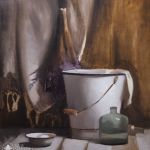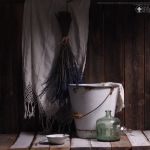- Lesson Details
- References
- Assignments
In this lesson, instructor Cornelia Hernes will teach you the foundational steps to embark on the underpainting phase of your still-life artwork. You will delve into an in-depth exploration of colors, understanding their nuances and mastering the techniques to mix them accurately. Cornelia will guide you through the block-in process, starting with the robust strokes of hog hair Bristol brushes, gradually transitioning to smoother brushes for refined details. Emphasizing the importance of observational tools and skills, she will demonstrate how to authentically express colors and values, ensuring each element in your composition resonates with its true essence. By the end of this lesson, you will have a solid grasp of the underpainting process, setting the stage for the subsequent layers of your artwork.
This lesson belongs to the course, Introduction to Still-life Painting II. In this 15-week course, immerse yourself in the intricate world of still-life painting with a focus on observational techniques and composition. Guided by the expert hand of Cornelia Hernes, you’ll delve deep into the art of capturing still-life in its most vivid form. Starting with the basics of composition setup and brainstorming, Cornelia will introduce you to the nuances of color theory, the importance of lighting, and the role of texture in bringing objects to life. You’ll explore the significance of each element in a composition, learning to give each its due importance. The course will also cover advanced techniques like imprimatura, sight-size drawing methods, and the art of capturing transparency in objects like glass bottles. Cornelia’s hands-on approach ensures that by the end of the course, you’ll not only have a deep understanding of still-life painting but also the skills to create pieces that resonate with realism and depth. This course is a continuation of Tina Orsolic’s “Introduction to Still-Life Painting I,” which can be found here. While it’s not mandatory to complete Course I, doing so will provide you with a stronger foundational understanding of this companion course.
Throughout this course, you’ll have access to the NMA community for feedback and critiques to improve your work as you progress.
You do not need to purchase specific materials to take this course.
We have included a materials list as recommendation only.
If you cannot find a specific material in your area, use the closest equivalent available to you.
Doing so will allow you to have the best possible learning outcome from this course.
For help with finding alternative materials, including how to take this course with digital tools,
please join our community Discord.
This lesson has 3D Models reference. Subscribe now
This lesson has Assignments. Subscribe now

 UPDATE! October 1st, 2023: This version of the website will no longer receive updates. Please transition to the new website for the best experience.
UPDATE! October 1st, 2023: This version of the website will no longer receive updates. Please transition to the new website for the best experience. 




CONNECT
New Masters Academy
16182 Gothard St
Huntington Beach, CA 92647
Contact US